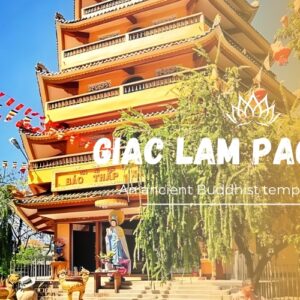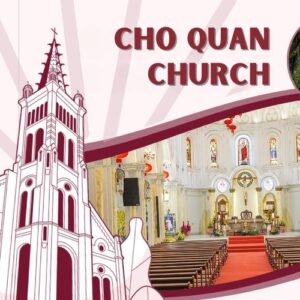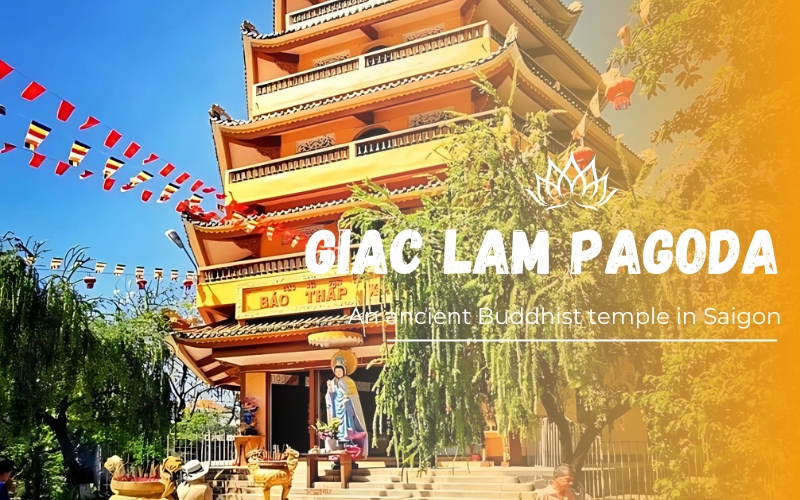
For those who love spiritual destinations in Saigon, Giac Lam Pagoda is probably the destination in the journey to explore the splendid Saigon. Let’s explore Giac Lam Pagoda to learn about the history, unique architecture and attractive activities at this pagoda through the article below.
General information about Giac Lam Pagoda
Address: 565 Lac Long Quan, Tan Binh District, Ho Chi Minh City
Opening hours: 7 AM – 9 PM
Entrance fee: free
Giac Lam Pagoda, also known as Giac Lam Tu, is an ancient temple located in Tan Binh District. This is a temple that is hundreds of years old, providing a close-up view of early 17th-century Buddhist architecture as well as a rare meditation space.
With a history of nearly 300 years, Giac Lam Pagoda has witnessed almost every change and fluctuation of this land, in addition, it is also the ancestral temple of the Lam Te sect in Southern Vietnam. In 1988, Giac Lam Pagoda was recognized as a National Historical and Cultural Relic and became a famous pilgrimage site for visitors from all over.
>>> Visiting Giac Lam Pagoda offers a glimpse into Ho Chi Minh City’s rich spiritual heritage, but there’s so much more to explore beyond its sacred walls. Discover the best Ho Chi Minh City tours that take you through the city’s vibrant streets, historic landmarks, and cultural treasures!

Giac Lam Pagoda
History of Giac Lam Pagoda
If you have the opportunity to visit Giac Lam Pagoda, visitors should learn about the history of the pagoda to fully understand the unique cultural and historical features here.
In the spring of 1744, under the reign of King Nguyen Phuc Khoat, the pagoda began to be built by lay people to serve the religious activities of several beliefs. Initially, people called the pagoda by many names such as Cam Son, Son Can or Cam Dem. In 1774, Zen master Vien Quang took over the pagoda and changed its name to Giac Lam Pagoda. At this time, Giac Lam became the leading center for training in Buddhist scriptures and precepts in the region, attracting a large number of Buddhists.
From 1939 to 1945, the pagoda was restored. During this time, some monks participated in the resistance war, the pagoda was used as a logistics base and a shelter for many revolutionary activists. In 1953, the pagoda received the Bodhi tree and the Buddha’s relic from Sri Lanka. At first, the Buddha’s relic was temporarily stored in a small golden tower at Long Van Pagoda in Dong Nai. After the stupa was completed at Giac Lam Pagoda, the relic was brought back to be enshrined.
On November 16, 1988, Giac Lam Pagoda was recognized as a National Historical and Cultural Relic. Up to now, Giac Lam Pagoda has been under the leadership of 8 generations of abbots, attracting thousands of tourists and Buddhists every year to visit and learn about the history and culture of Buddhism.
Main attractions of Giac Lam Pagoda
Typical architecture of Southern pagodas
Giac Lam is a typical pagoda, with an architectural style typical of the Tam-shaped architecture of Southern pagodas. Three horizontal rows of houses are connected together and arranged on a rectangular surface including the main hall, the lecture hall and the men’s house. To this day, Giac Lam Pagoda still maintains the architectural style imbued with the traditional culture and style of Southern pagodas in the past. The pagoda is designed in the shape of the letter Tam (Ξ), with three horizontal rows of houses connected together, arranged in a rectangular layout including the main hall, the lecture hall and the men’s house.
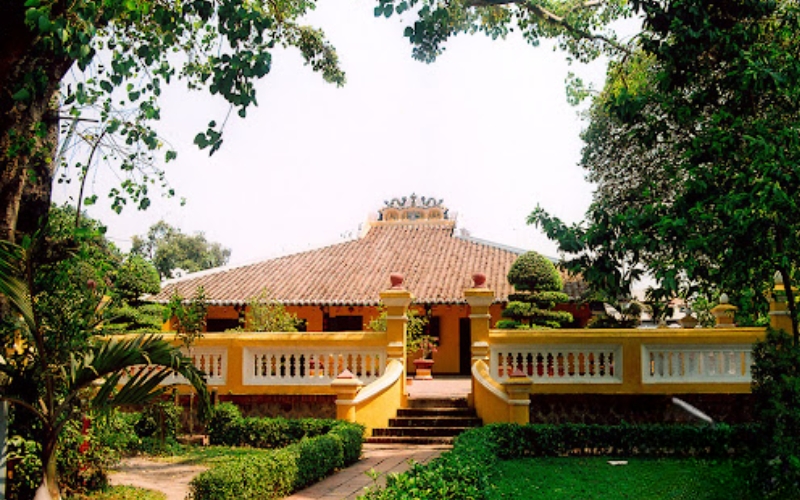
Giac Lam Pagoda has the Tam-shaped architecture of Southern pagodas
The two-door gate of Giac Lam Pagoda
The two-door gate was built in 1945, standing out with two lions at the two corners of the gate, bearing the Indian cultural features and the image of the Naga snake head, typical of Khmer Buddhism. The gate is designed in a kneeling position, decorated with typical embossed patterns. On the two-door gate is written a Chinese inscription about the legend of the Crown Prince of the Tang Dynasty. In addition, the temple gate is not built directly towards the main hall, according to ancient beliefs, to avoid ghosts and gods going straight into the main area of the temple.
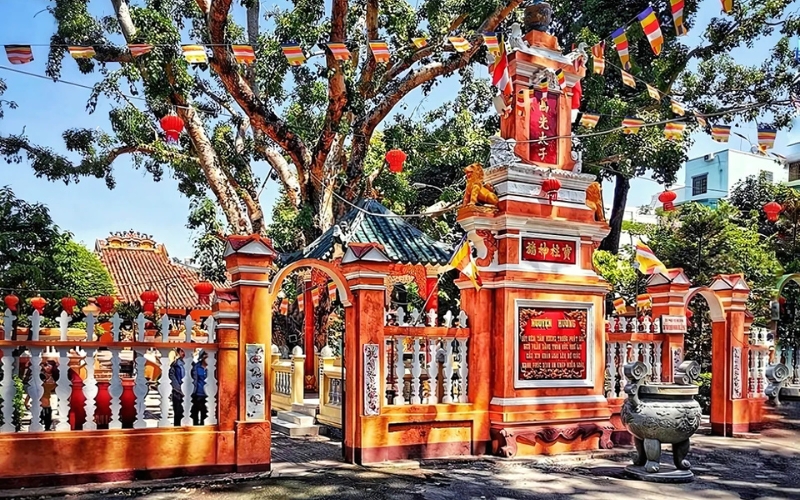
The two-door gate of the pagoda
Tam Quan gate
When it was first built, Giac Lam Pagoda did not have a Tam Quan gate. It was not until 1955 that the temple began to build a Tam Quan gate, facing south, located right next to the current Lac Long Quan Street. On both sides of the pillars are carved parallel sentences in Chinese characters.

Tam Quan Gate was built later in 1955
The temple roof
The roof of Giac Lam Pagoda is designed in the shape of a banh it, which is very popular in Southern architecture. This gives visitors from all over the world a feeling of closeness and rusticity. The roof has four flaps, straight ridges, without the knife-shaped frills like in communal houses and pagodas in the North. On the top of the roof is the image of “two dragons fighting for a pearl” showing solemnity and respect.
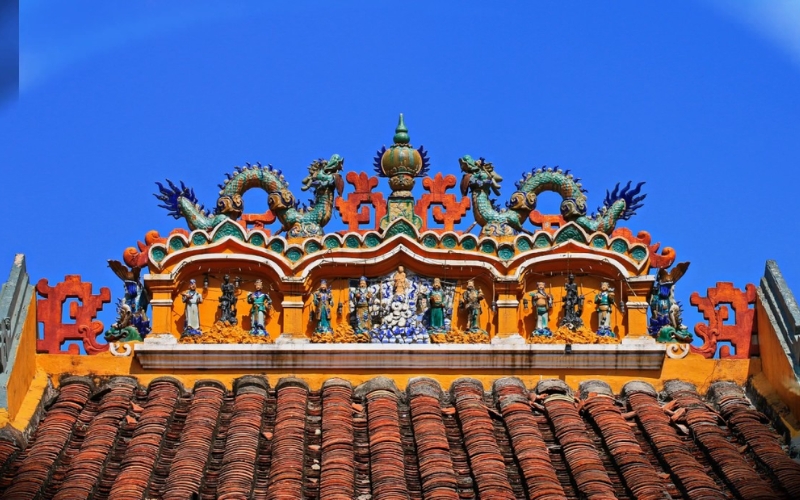
The roof of Giac Lam Pagoda
Main hall
The main hall of Giac Lam Pagoda is built with a traditional two-wing room, with four main pillars called tu tru, arranged in the style of “first worship Buddha, then worship the ancestors”. The pagoda also has a system of more than 56 large dark brown columns. On the columns are elaborately carved parallel sentences and elaborately decorated with traditional themes such as: four sacred animals, flowers and birds, four seasons…
The worship area inside the main hall is even more brilliant and magnificent. Visitors can admire many large statues such as Buddha Amitabha, and Buddha Shakyamuni,… along with the Nine Dragons statue cast in bronze. The solemn worship hall has three tables inside and outside, high and low respectively: Amitabha table, Council table, and Tam Bao table.
The most special thing is that the top of the main hall wall has more than 6,000 decorative plates. The Hong Hung ancestral tower also has more than 1,000 plates attached. These plates are mainly fired from the Lai Thieu pottery kiln in Binh Duong province. In addition, some plates originate from Japan and China. With more than 7,000 plates, Giac Lam currently holds the record for “the pagoda with the largest number of decorative plates in Vietnam”.

Inside the main hall of Giac Lam Pagoda
Behind the main hall
Behind the main hall of the pagoda is the Ancestor’s altar – where the abbots of Giac Lam Pagoda are worshiped. Opposite the Ancestor’s altar is the altar of Chuan De Buddha, Amitabha Buddha and the Ten Kings of Hell.
Behind the Ancestor’s altar is the lecture hall area designed in the style of the main hall’s roof. This is where monks come to attend important events or major ceremonies in the pagoda. During the resistance war against French colonialism and American imperialism, the lecture hall was used to house cadres and conduct reconnaissance work in the inner city.
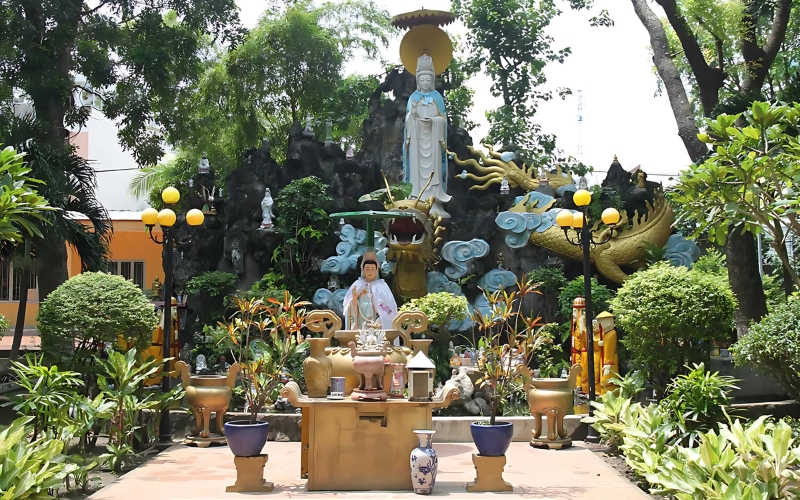
The Buddha statue behind the main hall
What to do at Giac Lam Pagoda
Visit the impressive works at the pagoda
The pagoda has some outstanding attractions that you cannot miss when visiting such as:
- Xa Loi Stupa: This Stupa is hexagonal in shape and consists of seven floors. This tower began construction in 1970 according to the design of architect Vinh Hoang and then stopped in 1975. In 1993, the construction was resumed and the Xa Loi Stupa of Giac Lam Pagoda was completed in 1994. This tower is 32.7m high, has an area of more than 600m2 and faces North.
- Admire the antiques preserved at Giac Lam Pagoda with 119 statues and many precious wood carvings such as horizontal lacquered boards, parallel sentences, altars and many ancient worship items
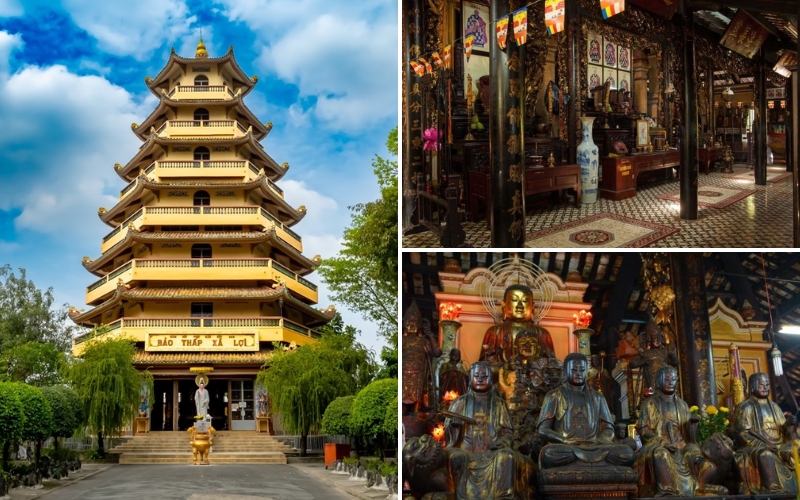
Xa Loi Stupa and other precious wood carvings of the pagoda
Participate in other religious activities
You can participate in retreats to listen to sermons on Buddhism and practice patience. This will help you understand Buddhism more deeply and feel the sacred atmosphere, pray for your family and loved ones. During religious holidays such as the full moon of January, Vu Lan festival or Buddha’s birthday, visit the pagoda to participate in Buddhist ceremonies, pray for peace and enjoy the solemn and respectful atmosphere at the pagoda. There are also many special activities such as asking for lucky words, asking for fortune-telling, and choosing wedding dates,…
>>> Ho Chi Minh City is not only home to sacred temples like Giac Lam Pagoda but also hosts some of Vietnam’s most vibrant and culturally significant festivals throughout the year. Let’s explore the best festivals in Ho Chi Minh City that you won’t want to miss!
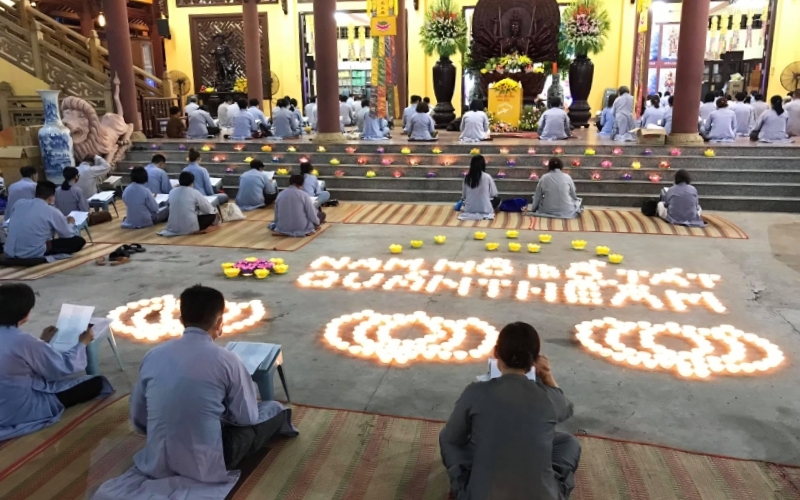
A retreat held in Giac Lam Pagoda
Experience food at nearby vegetarian restaurants
Dining at vegetarian restaurants near Giac Lam Pagoda is a great way to experience Ho Chi Minh City’s rich plant-based cuisine. Many eateries in the area offer a variety of delicious and nutritious dishes, from traditional Vietnamese vegetarian meals to modern fusion options. These restaurants often offer a peaceful and welcoming atmosphere, making them ideal for a relaxing meal after visiting the pagoda. Some nearby vegetarian restaurants include Shamballa Vegetarian Restaurant, Hoa Nhon Vegetarian Restaurant or Hoang’s Kitchen,…
>>> Discover more of famous vegetarian restaurants in Ho Chi Minh City with this article.

Shamballa Vegetarian Restaurant
Tips to know before visiting Giac Lam Pagoda
When traveling to Giac Lam Pagoda, visitors need to pay attention to some important things to have a complete trip:
- Choosing the right outfit is very important. When going to Giac Lam Pagoda, visitors should choose polite and formal clothes. Wear long-sleeved, discreet clothes and at least a skirt above the knee. Avoid wearing short clothes and thin materials that are not suitable for visiting Giac Lam Pagoda
- When coming to Giac Lam Pagoda, visitors need to pay attention to respecting the believers and always follow the instructions of the pagoda management board. You can take pictures but always be respectful when taking pictures, especially in the worship area, the main hall and the monks.
- During the visit to Giac Lam Pagoda, visitors need to be aware of keeping the pagoda clean, and not littering. It is a sacred space, so when coming to the pagoda, you need to walk slowly, talk softly, and avoid making noise that affects the solemn atmosphere.
- Giac Lam Pagoda is located about 6km from the city center, you can get there in many ways, the most popular are bus, taxi or ride-hailing apps like Grab and Be. In addition, for a more novel experience, you can rent a motorbike to see the local streets.
As a famous ancient pagoda, Giac Lam Pagoda has unique architecture and has become an attractive destination for many tourists. This is also a historical relic, witnessing the ups and downs and fluctuations of the city for more than 300 years. Hopefully after this article, you will have the necessary information to prepare for your upcoming trip to Ho Chi Minh City.
Read more:

